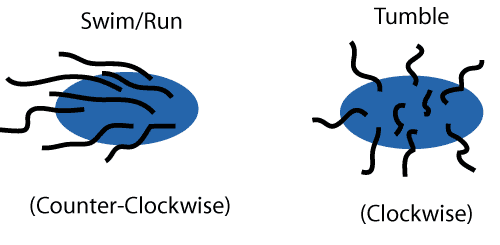
Finding Food
Putting it all Together
What does all of this have to do with finding food?
"Food" for bacteria is usually a simple sugar, such as glucose. If sugar is floating around in solution, it usually exists in higher concentration in some areas than others, particularly if there is a sugar source in the solution. Bacteria use chemotaxis to "wander" towards the sugar source.
In the video below, the dark pink circle represents a food source and the black dots all represent individual bacteria finding the food source through a random walk, biased by the concentration gradient. All of the black dots start out away from the food source, but move in closer by a biased random walk.

How do bacteria undergo random walks?
One common mechanism for bacteria to undergo random walks is the so-called "run and tumble" method. This method is used by bacteria that have several flagella (little whip-like propellers that help them swim). When rotating in one direction, the flagella all work together to propel the bacterium, creating a straight swim. Because of the way that the flagella are shaped, they don't propel the bacterium when rotating in the opposite direction, but rather cause the bacterium to "tumble" so that when it starts swimming again, it is moving in a random direction. By alternating "runs" and "tumbles," a bacterium can undergo a random walk. The "runs" are the steps in a random walk and the "tumbles" are the random changes in direction.
E. Coli is an example of a bacterium that uses the run and tumble method to randomly walk. When the flagella rotate counter-clockwise, they cause a swimming motion, and when they rotate clockwise, they cause a tumble. The cartoon below illustrates this principle.

Can chemotaxis be used for purposes other than finding food?
The process of chemotaxis is not just used for finding food. Bacteria can also use it to move to lower concentrations of poisons. Can you guess how they do this? They bias their random walk down the concentration gradient (towards low concentrations) of poisons.
I had no idea that a little critter without a brain could do all of that!
It's pretty amazing how nature finds a simple enough way for a small organism with no brain to find food. Nature is full of little surprises like these for the survival of primative organisms. At the other end of the spectrum, there is a species with enough curiosity and intelligence to figure out how no-brained organisms find food -- us!
 |